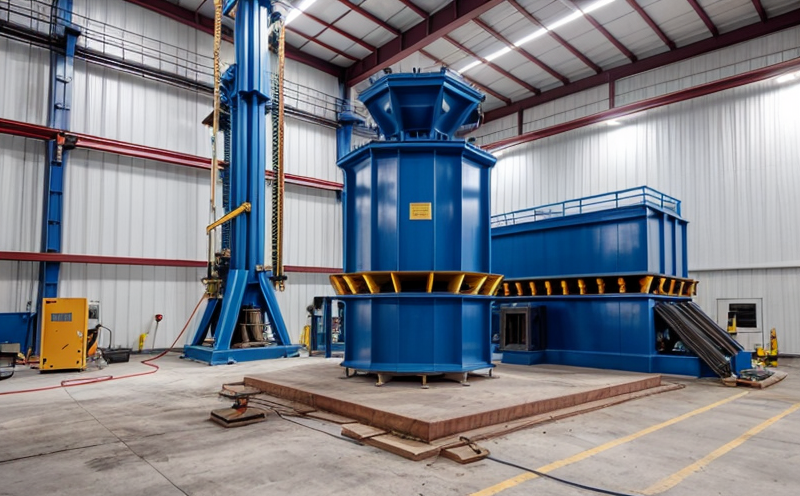ISO 10865 Shipboard Structural Vibration Testing
The ISO 10865 standard is specifically designed to address the vibration and structural integrity of shipboard structures. This testing ensures that ships are capable of withstanding the dynamic loads imposed by high seas, engine operation, and other operational stresses over their lifetimes. Compliance with this standard is crucial for ensuring maritime safety and longevity.
The key aspects of ISO 10865 include modal analysis, which involves measuring the natural frequencies and mode shapes of the structure to understand its dynamic behavior under various loading conditions. This process helps in identifying any potential areas of structural weakness or resonance that could lead to failure. The testing also includes impact excitation methods where specific points on the ship's hull are subjected to controlled impacts to assess how they respond.
For compliance with ISO 10865, the laboratory must use advanced instrumentation such as accelerometers and strain gauges to collect accurate data. These instruments are calibrated according to international standards like ISO/IEC 17025 to ensure reliability and accuracy of the test results. The specimens for testing typically include various components of a ship's structure, from bulkheads to decks.
The acceptance criteria under this standard are stringent and are designed to identify any structural deficiencies that could compromise safety at sea. Failure modes are carefully considered in the design phase of new ships or modifications to existing ones. This ensures that all critical areas such as engine rooms, cargo holds, and passenger areas meet stringent vibration thresholds.
Understanding the real-world implications is essential for quality managers and compliance officers who need to ensure their vessels comply with international maritime regulations. R&D engineers can leverage this testing to innovate and improve ship design while ensuring safety standards are met. For procurement teams, understanding these tests ensures they specify materials and components that meet these rigorous requirements.
During the test process, specimens undergo various loading conditions simulated on a shaker table or through environmental chambers. This allows for precise measurement of structural responses under controlled laboratory settings which mimic real-world scenarios more accurately than field testing. The data collected is then analyzed using sophisticated software to determine compliance with ISO 10865.
The importance of this testing cannot be overstated, especially considering the critical role ships play in global trade and safety at sea. By adhering to these standards, shipbuilders can ensure their products are not only safe but also efficient and reliable.
Industry Applications
| Application | Description |
|---|---|
| New Ship Design Validation | Ensuring new designs meet required vibration standards. |
| Existing Ship Retrofitting | Evaluating the impact of modifications on structural integrity. |
| Component Testing | Verifying parts and materials used in ship construction. |
| Performance Monitoring | Tracking long-term performance to anticipate maintenance needs. |
| Compliance Audits | Ensuring all testing meets international maritime standards. |
| Research and Development | Developing new materials and techniques for ship construction. |
The table above highlights how ISO 10865 is integral to various stages of the shipbuilding process, from initial design through to ongoing performance monitoring. Each application underscores the importance of this standard in maintaining maritime safety and efficiency.
International Acceptance and Recognition
The ISO 10865 standard is widely recognized and accepted by major maritime regulatory bodies worldwide, including the International Maritime Organization (IMO) and various national shipping authorities. This broad acceptance ensures that compliance with this standard is a global requirement for shipbuilders.
International recognition of ISO 10865 also facilitates trade between countries, as it provides a uniform set of criteria for assessing structural vibration in ships. Compliance can be a key factor in obtaining certifications and approvals from different regions, thereby enhancing the marketability of ships on an international scale.
The standard is regularly updated to incorporate advances in technology and materials used in shipbuilding. This continuous improvement ensures that ISO 10865 remains relevant and effective in addressing current challenges faced by the maritime industry.
For companies operating globally, adherence to this standard can open doors to new markets and partnerships. It also helps in maintaining a high level of safety and reliability across all ships built or retrofitted according to these standards.
Use Cases and Application Examples
In practice, ISO 10865 is used extensively in the marine industry for various applications. One common use case involves the validation of new ship designs before they enter production. By using this standard during the design phase, engineers can identify potential issues early on, reducing costs and delays associated with redesigns later in the process.
Another critical application is in the retrofitting of existing ships. As ships age, their structures may weaken due to wear and tear or exposure to harsh environments. Testing according to ISO 10865 helps determine if modifications are necessary to maintain safety standards without compromising structural integrity.
Component testing plays a vital role in ensuring that materials used in ship construction meet the required vibration resistance levels. This is particularly important for critical components like engine mounts and propeller shafts, which can significantly affect overall vessel performance.
Performance monitoring allows operators to track long-term performance trends, helping them anticipate when maintenance or replacement might be necessary. This proactive approach not only extends the life of ships but also reduces unexpected downtime and associated costs.
Compliance audits ensure that all testing conducted aligns with international maritime standards. These audits provide peace of mind for shipowners by confirming their vessels meet stringent safety requirements, thus fostering trust among stakeholders.
In research and development efforts, ISO 10865 serves as a benchmark against which new materials and techniques can be evaluated. This helps drive innovation within the industry while ensuring that any changes made do not compromise existing safety standards.





